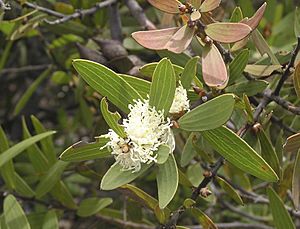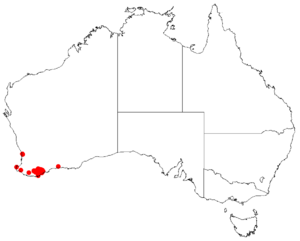Hakea ambigua facts for kids
Quick facts for kids Hakea ambigua |
|
|---|---|
 |
|
| Hakea ambigua in the Stirling Range National Park | |
| Scientific classification | |
| Genus: |
Hakea
|
| Species: |
ambigua
|
 |
|
| Occurrence data from Australasian Virtual Herbarium | |
| Synonyms | |
|
Hakea trinervis Meisn. |
|
Hakea ambigua is a type of shrub that belongs to the Proteaceae plant family. When it grows in good conditions, it can become a beautiful plant with branches that hang down and creamy white flowers. You can only find this special plant in the Stirling Ranges area of southern Western Australia.
What Hakea ambigua Looks Like
Hakea ambigua is an upright shrub that can grow from about 1 to 3 metres (3 to 10 feet) tall. It has smooth, grey bark. Unlike some plants, it doesn't have a special woody rootstock (called a lignotuber) that helps it regrow after a fire. Its smaller branches are a bit hairy.
The leaves are smooth and a mid-green colour. They grow one after another along the stem. Each leaf is about 40 to 100 mm (1.6 to 3.9 inches) long and 5 to 18 mm (0.2 to 0.7 inches) wide. The leaves are wider in the middle and have three veins running lengthwise on both sides. They end in a slightly blunt point.
The flowers are sweetly scented and are usually creamy white or yellow, sometimes with a hint of pink. They grow where the leaves meet the stem, appearing from August to October. The small stalks that hold the flowers (called pedicels) are about 3 to 4 mm (0.1 to 0.2 inches) long. The flower parts (perianth) are smooth and about 5 to 6 mm (0.20 to 0.24 inches) long. The part of the flower that receives pollen (the style) is smooth and has no hairs.
After the flowers, the plant produces smooth, rounded fruits. These fruits can be up to 4 cm (1.6 inches) long and 1 to 1.5 cm (0.39 to 0.59 inches) wide. They narrow down to a noticeable beak-like tip.
Hakea ambigua can be useful for stopping soil from washing away (erosion control). It can also be used to create hedges and provides a home for wildlife.
Naming and Discovery of Hakea ambigua
The plant Hakea ambigua was first officially described by a botanist named Carl Meissner in 1848. He wrote about it in a book called Plantae Preissianae. The very first sample of this plant that was used for its description (called the type specimen) was collected by James Drummond near the Swan River.
The second part of the plant's scientific name, (ambigua), comes from a Latin word. Ambigua means "of double meaning," "doubtful," or "uncertain." It's thought that Meissner chose this name because he wasn't sure how this species was related to other plants.
Where Hakea ambigua Lives
Hakea ambigua is found in areas along the southern coast of Western Australia. Most of these plants grow in the Stirling Range.
You can find Hakea ambigua on hillsides, usually in areas with many shrubs (shrubland) or where small, multi-stemmed trees grow (mallee). It prefers sandy, rocky soil that contains quartzite and also gravelly loam. This plant needs a sunny spot and soil that drains water well.

